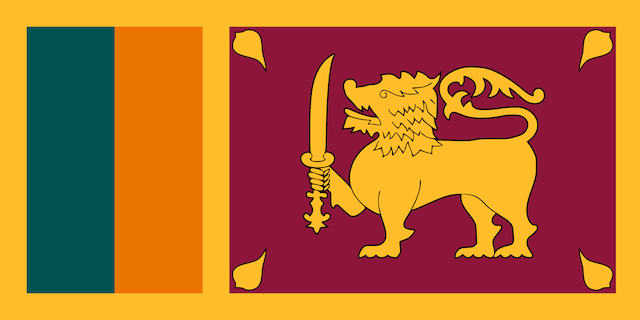Trincomalee - General Info
Description:
This large military port is located in the northern half of the east coast of Sri Lanka. It is one of the largest harbors in the world and can be entered in any conditions.
For years, cruising boats heading to Sri Lanka only had the one option when clearing into the country, and that was Galle in the SW. Trincomalee was in Tamil Tiger territory and not considered a safe destination during the civil war that dragged on from 1986 to 2009.
Trincomalee’s unspoilt beaches have made it an increasingly popular tourist destination in recent years, and slowly but surely the cruising community are starting to use it as a quieter alternative to Galle.
Cruiser Highlights:
Cleaner and quieter than Galle; clearance port; safe all-weather harbor; close to the Cultural Triangle; outstanding national parks nearby.
Entrance Notes and Cautions:
- Under no circumstances is entry permitted at night.
- There are no lit buoys and the harbor master is not willing to be responsible for any yacht’s night time entry or departure.
- As you approach Trincomalee beware of fishing boats casting their nets. Some of these nets are at least 1.5NM long, only marked with a flashing light at the outer end. Be sure to avoid sailing between the fishing boat and the flashing light.
- On approach, call Port Control on VHF 16 when you get near Elephant Island. In most cases, they will already know that you are approaching the port, as informed by the Navy, and will hail you on VHF 16. VHF Channel 10 is used as the port working channel. The port controllers are very professional and speak perfect English. They will ask you several questions before giving you permission to pass into the port via Elephant Pass.
- Port Control may also ask if you want a pilot boat’s assistance to enter the port. This is not necessary and does carry a charge.
- For any vessel, entry and movement within the harbor are strictly controlled.
Position:
08° 32″N, 81° 13″E (Outer harbor entrance)
Read and Post Related Comments
If you have information for this section, or feedback on businesses used, please let us know at editor@noonsite.com. We also welcome new information about businesses you have used (see Related Businesses).
Next Section: Profile: Clearance
Related to following destinations: Sri Lanka, Trincomalee
Port Navigation
Courtesy Flag Discounts


YachtFlags.com provides high quality courtesy flags that are manufactured in durable Knitted Polyester fabric. Knitted so that the fabric itself does not deteriorate in the constant movement that marine flags are usually exposed to, and polyester so that the flag does not weaken in the strong UV-light usually found in the main sailing areas of the world.
YachtFlags.com offers a discount to Noonsite members.
Use the coupon code NOONSITE-5A2B when checking out to get 10% off today.
Buy Now On YachtFlags.comMain Ports - Sri Lanka
Courtesy Flag Discounts


YachtFlags.com provides high quality courtesy flags that are manufactured in durable Knitted Polyester fabric. Knitted so that the fabric itself does not deteriorate in the constant movement that marine flags are usually exposed to, and polyester so that the flag does not weaken in the strong UV-light usually found in the main sailing areas of the world.
YachtFlags.com offers a discount to Noonsite members.
Use the coupon code NOONSITE-5A2B when checking out to get 10% off today.
Buy Now On YachtFlags.com


Approaching Trincomalee
we sailed from Malaysia , Langkawi island on 8 Jan 2020 it took us 8 days to arrived to Sri Lanka, Trincomalee .
The passage was nice especially after we clear Somatra Island we had very nice NE wind al the way some time it reach 25 knt, the current was on our nose and starboard fore beam most of the time it reached 2 knt.
Be a wear :
1. We been approached 2 times by fishing boat they were very pushy the followed us ,it took long time make them stop (we used the engine and cross our hands to make them understand to stopped).
2. We planned to arrive to Trinco morning as it not allowed to inter at night, we notice a lot of fishing boat were drafting with their nets , the net will be 1.5 nm long our longer than that , in the end of the net will flashing light, so avoid to inter between the boat and the flashing light.
The total clearance charges for a one month stay we been asked by our agent US$230.
best Regards,
Comments please write to me (Abdullah_ys@yahoo.com)
Abdulla Alsulaiti
Hello,
We are planing to sail to Sri-Lanka this December. We found your review very instructive and helpful, since finding infirmation on cruising boat for this country is quite difficult.
Our sailboat Acalephe is actually cruising around Laangkawi in Malaysia heading to the Med via the Suez Canal.
We will have an insurance problem to solve soon: our insurer, Concept Special Risks, doesn’t want to insure us after Malaysia.
Please, would it be possible for you to suggest us an Insurance company that would insure us, at least for liability only, in ordre to get to Sri Lanka?
Many thanks for your collaboration!
Have a nice day!
Jean Gilles Lemieux
David Berger
Sailboat Acalephe
We first called Trincomalee Port Control on VHF16 about 10 to 15 nm outside of the harbour. They advised to proceed to Round Island in the outer harbour and contact them when we arrived. We did so and were instructed to proceed to town Jetty in Town Bay.
We had previously contacted our GAC Agent before leaving Phuket, to advise them of our estimated arrival time. They were there to meet us before the clearing in authorities arrived.
All clearing in went smoothly with friendly people and no problems.
Our GAC contact Sandeep Kavinda has been very helpful and has contacted us every day since arriving to see if we needed anything. We have nothing but good words for GAC and Sandeep.
We also found a good guide, Yoosuf, who has very reasonable rates and is very helpful with finding anything a yachtie wants. He has a tuk-tuk for getting around town and a minivan for touring to further distances. Very trustworthy, reliable, happy disposition and can trust him not to overprice.
Can contact Southern Wing Facebook page for Yoosuf’s phone number or southernwing60(at)Gmail(dot)com.
We have had a great time in Trincomalee and found it to be a very interesting and friendly place to visit.
Just a note: Port Authorities require notification as to where you anchor and if you shift at any time. We anchored about 300 meters south to SW of the Jetty. An excellent calm anchorage with good holding and a safe place to leave your boat to go touring for 4 or 5 days.
Spare parts in Trinco: 23.2. 2017
We sailed to Trinco since it is said to be a safe place to leave your boat for a trip overland to visit the old cultural sites inside Sri Lanka. And clearing it shall be easy and even a bit less expensive than Galle.
First is true, second not so clear. For clearance, our agent Mr Priyantha from Isle Shipping(Pvt)Ltd charges a total of 300 US$ (Harbour fee, his handling etc), don’t know how this compares to Galle.
But should you need a spare for broken gear while in Trinco, bad luck hits you double! We needed a new clutch for the watermaker. It starts sounding good. In Sri Lanka, you need not to pay import tax or duty for spares. But this results in the most ridiculous cost driving customs clearing procedure we have ever heard of.
Your spare, after arriving in Colombo airport, is detained by customs and needs to be delivered to Trincomalee (300 km from Colombo) under customs supervision. As per our agent, this requires a customs officer from Colombo to be driven by car to Trinco, with the spare part on his lap, where he delivers it to the captain, so to make sure the part goes really on a foreign boat and returns home. All at your cost, arranged by your agent.
In our case he quoted 50$ FedEx and customs, custom under supervision charges 115 US$, Transport charges US$ 250, Documentation charges (??) US$ 35 and agents handling charges US$ 50 neatly sums up to 500 US$, more than the parts cost plus transport from Trinidad to Sri Lanka! After our protests he reduced to total 435US$, still exceeding the parts value.
To top that: we anchor here in Trinco 100 m from the port customs office, but they are not involved?
This note is a warning and an inquiry if ever anyone else has come across this Sri Lanka speciality?
One more note to Sri Lanka: Be aware that your cooking gas bottle cannot be filled here anywhere. They have a strict exchange policy, return empty, get the full one, so no one needs filling or does it offer.
Josef Oehlinger,
SY Sanuk II
At present we cannot recommend Trinco as an alternative to visiting in Sri Lanka. Although Trinco has an excellent and safe anchorage in the NE monsoon season the harbour authorities have levied charges over and above over harbours such as Galle. As a result of being guided when first arrived in Trinco to a rusty barge for the tie-up, we have been charged for moorage.
An additional charge for anchoring has also been levied. There are charges for pilotage although we did not request this service. In total the charges incurred for a one month stay apart from our agent’s fee has amounted to US$273!
There are 7 yachts currently in the harbour and each of the yachts are experiencing similar problems.
Until the authorities are transparent and charges over and above agents fees are clearly detailed we cannot recommend visiting Trinco.
We entered Trincomalee outer harbour and were met by a marine commando unit. Entrance to the harbour is accessed usually by going to the pilot station located just outside the harbour entrance. After being closely escorted by the commando unit to the pilot station we were then able to contact the harbour authorities. We were escorted by a pilot boat to a container ship wharf where we were met by our previously arranged for an agent from GAC shipping.
We stayed tied to the container ship wharf until early morning when we were shifted to Mud Cove jetty and tied up to a barge. The Mud Cove jetty is part of the harbour authority properties and is located 4km from the main town. This is the most secure location as the property is well guarded and gated but it is not that convenient to town.
Trincomalee is truly a large natural harbour with great potential for anchorages but everything is closely controlled and moving the boat is not an option without advance permission from the harbour authorities.